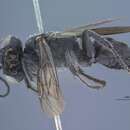Comprehensive Description
provided by Smithsonian Contributions to Zoology
Tachysphex drymobius Pulawski
PREY.—Karunaratne collected a female, 9.5 mm long, flying with her adult male cockroach prey, 14 mm long, at noon on 15 January 1975. The wasp was flying along an abandoned logging road made from fill of gravelly soil and sand in the Kanneliya section of the Sinharaja rain forest, Galle District. The prey belonged to a species of Lupparia or a related genus.
- bibliographic citation
- Krombein, Karl V. and Pulawski, W. J. 1994. "Biosystematic Studies of Ceylonese Wasps, XX: A Revision of Tachysphex Kohl, 1883, with Notes on other Oriental Species (Hymenoptera: Sphecidae: Larrinae)." Smithsonian Contributions to Zoology. 1-106. https://doi.org/10.5479/si.00810282.552
Comprehensive Description
provided by Smithsonian Contributions to Zoology
Tachysphex drymobius Pulawski
NAME DERIVATION.—Drymobius is a combination of two Greek words, drymos (forest, wood), and bios, (life; a woods dweller.)
DIAGNOSIS.—Tachysphex drymobius is very similar to changi (see that species for differences, page 54). A character differentiating the male from extralimital species is: vertex width at most 1.1 × length.
DESCRIPTION (see also xanthoptesimus, page 50).—Many scutal punctures one or two diameters apart. Mesopleural punctures below scrobe averaging one diameter apart or less. Episternal sulcus complete. Propodeal dorsum rugose or irregularly ridged longitudinally. Hindcoxal dorsum: inner margin weakly angulate basally.
Setal length expressed as a fraction of basal mandibular width: 0.2–0.3 on vertex, 0.4 along hypostomal carina, 0.3 on scutum (setae inclined posterad), 0.2 on midfemoral venter (setae nearly erect); setae of propodeal dorsum slightly inclined posterad, essentially erect.
Head, thorax, and legs black, humeral plate dark brown. Terga I–III silvery fasciate apically. Wings slightly infumate. Frontal vestiture silvery.
.—Clypeus: bevel ill defined, as long as basomedian area or shorter; lip with two lateral incisions on each side. Vertex width 0.9–1.0 × length. Dorsal length of flagellomere 12.2–2.4 × apical width. Forefemoral venter with fine punctures that are several diameters apart. Forebasitarsus with 9–11 rake spines. Venter of tarsomeres V with central cluster of spines and with row of spines on each lateral margin. Length 8.5–10.0 mm.
.—Clypeus: lip arcuate or sinuate, with small median notch in some individuals; distance between lip corners equal to 0.6 of distance between corner and orbit. Vertex width 1.0–1.1 × length. Dorsal length of flagellomere I 1.8 × apical width, equal to 0.8 of II. Forefemoral notch finely setose. Venter of tarsomeres V with a few minute, preapical spines. Sterna III–VI with large punctures that are several diameters apart, with the usual long bristles at base of apical depressions, and also with suberect, sparse setae that are about as long as midocellar diameter. Length 7.2–8.5 mm. Volsella: Figure 126. Penis valve: Figure 127.
COLLECTING PERIOD.—11–16 January, 8–12 February, 11–12 March.
HABITAT.—This uncommon species apparently occurs only in lowland rain forest where average annual rainfall may be as great as 3900 mm at elevations of 150–400 m (Figure 128).
GEOGRAPHIC DISTRIBUTION.—Southwestern Sri Lanka.
RECORDS.—Holotype: , Sri Lanka, Galle District, Kanneliya Jungle, 15 Jan 1975, P.B. Karunaratne, Biological Record 11575 F (USNM).
Paratypes: SRI LANKA: GALLE DISTRICT: Kanneliya Jungle, KVK (1, USNM), Kanneliya Jungle, KVK, PBK, PF, NVTAW (2, 3, CAS; 3, 5, USNM), Hiniduma in Kanneliya Jungle, KVK (1, 2, USNM). RATNAPURA DISTRICT: 2 mi (3.2 km) S Weddagala, Sinharaja Jungle, KVK, PF, DWB, VG (1, 1 CAS; 1, 1, USNM).
- bibliographic citation
- Krombein, Karl V. and Pulawski, W. J. 1994. "Biosystematic Studies of Ceylonese Wasps, XX: A Revision of Tachysphex Kohl, 1883, with Notes on other Oriental Species (Hymenoptera: Sphecidae: Larrinae)." Smithsonian Contributions to Zoology. 1-106. https://doi.org/10.5479/si.00810282.552

